Ruth Ellen Gruber's Blog, page 16
August 29, 2011
European Day of Jewish Culture Next Sunday
By Ruth Ellen Gruber
Here's a reminder that the 12th edition of the annual European Day of Jewish Culture will take place next Sunday, September 4.
The schedule of events for many of the participating countries can be found HERE.
The theme this year is "EDJC 2.0: Facing the Future." As the web site puts it:
As usual, Italy is the most enthusiastic participant with a wide range of programming in more than 60 towns and cities up and down the peninsula. The main official events will take place in Siena.
Here's a reminder that the 12th edition of the annual European Day of Jewish Culture will take place next Sunday, September 4.
The schedule of events for many of the participating countries can be found HERE.
The theme this year is "EDJC 2.0: Facing the Future." As the web site puts it:
Jewish heritage in the era 2.0: new approaches to promotion and preservation using the new tools of communication, representation and exchange
The new era of communication has opened up a world of new possibilities for presenting and highlighting Jewish Culture and heritage.
Whether it is graphic design, videos, films, internet forums, etc., they all offer the opportunity of both a new view on already known aspects, and of tackling the subject in a totally different way, using the ever increasing facilities for sharing information interactively in a social media dialogue.
As usual, Italy is the most enthusiastic participant with a wide range of programming in more than 60 towns and cities up and down the peninsula. The main official events will take place in Siena.
Published on August 29, 2011 03:34
August 28, 2011
Synagogues -- great new resource on Tumblr and Twitter
By Ruth Ellen Gruber
Thanks to Barbara Kirshenblatt-Gimblett for turning me on to a wonderful new resource on synagogues -- a Twitter feed and also Tumblr blog called "A synagogue a day" that showcases daily images from the William A. Rosenthall Judaica Collection at the College of Charleston special collections.
The images include both historic and contemporary postcards and photographs of synagogues all over the world, interior and exterior shots. Worth a look to see the vast diversity of architecture -- and geographical spread!
Thanks to Barbara Kirshenblatt-Gimblett for turning me on to a wonderful new resource on synagogues -- a Twitter feed and also Tumblr blog called "A synagogue a day" that showcases daily images from the William A. Rosenthall Judaica Collection at the College of Charleston special collections.
The images include both historic and contemporary postcards and photographs of synagogues all over the world, interior and exterior shots. Worth a look to see the vast diversity of architecture -- and geographical spread!
Published on August 28, 2011 02:43
August 26, 2011
Italy -- Italian Jewish Food lets you travel via your taste buds

Sign advertising kosher products in Pitigliano, Italy. Photo (c) Ruth Ellen Gruber
By Ruth Ellen Gruber
If you can't hop over to Italy, you can "get a taste of Jewish Italy" by sampling of the recipes of Italian Jewish dishes Joan Nathan spotlights in an article in Tablet Magazine. She also recommends a sampling of cookbooks featuring Italian Jewish cuisine.
If you want to dine less vicariously on Jewish Italian favorites -- there is a growing number of Jewish (even kosher) restaurants in Rome, Florence and elsewhere.
One of my favorites in Rome is called Ba' Ghetto -- it is in the old Ghetto neighborhood, around the corner from the main synagogue. Nice selection of local and Mediterranean Jewish food; relaxed but slightly upscale ambience.
Published on August 26, 2011 11:23
August 24, 2011
Slovakia -- Trencin and the mixed emotions of visiting Jewish sites
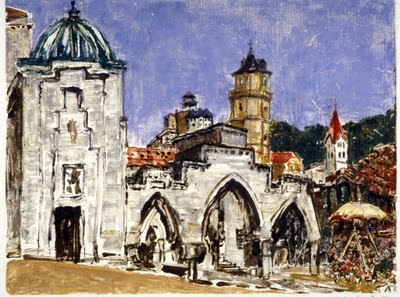
Synagogue in Trencin, 1993. Monotype by Shirley Moskowitz (c) estate of Shirley Moskowitz
By Ruth Ellen Gruber
There usually comes a time when you visit sites of Jewish heritage in Eastern and Central Europe when the impact of the past -- the destruction wrought in the Holocaust -- breaks through and grabs you. I have experienced this often: I love looking at the synagogue buildings and admiring the architecture and recalling the richness of Jewish history and recognizing their importance to the cultural heritage of society at large and applauding the way that many by now have been restored for cultural use. Likewise when I thrill to the wonderful carving on Jewish gravestones and appreciate the creativity and aethestic verve that produced them. Still, I sometimes find myself unexpectedly choked up, even weeping.
I wrote about these contradictory feelings at length in the introduction to my book Jewish Heritage Travel.
And Rabbi Andrew Goldstein touched on this theme in the sermon he gave after our trip to Slovakia this month following the Slovak Jewish Heritage Route (which I posted HERE). That is why he and his wife, Sharon, held informal "services for synagogues" in a couple of the synagogues we visited -- notably the still semi-ruined one in Liptovsky Mikulas and the Status Quo synagogue in Trnava, now an art gallery.
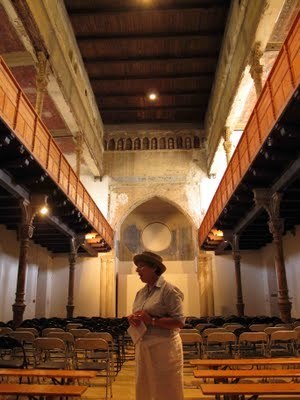
Sharon Goldstein chanting in the Trnava Status Quo synagogue. Photo (c) Ruth Ellen Gruber
My friend, the wonderful (and wonderfully outspoken) musician Mark Rubin experienced this several years ago when he visited the Slovak town of Trencin and saw the magnificent synagogue there -- one of the most impressive buildings in town, besides the hilltop castle.
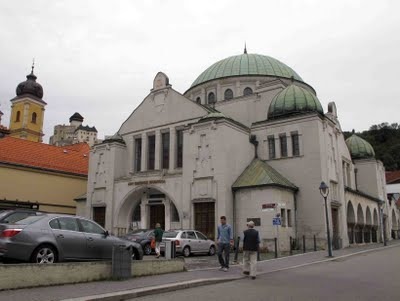
Trencin synagogue with hilltop castle in the background. Photo (c) Ruth Ellen Gruber
Mark wrote a lengthy, eloquent -- and angry -- post about his feelings on his blog.
There indeed is a fine synagogue in Trencin, but there will be no shabbes here. There are no Jews here. The stark, sudden and complete realization that though this building may still stand and from the outside is beautiful and all, there are no Jews here to pray with. Not tonight, and probably never again I imagine. A wave of depression and sadness flushes over me. I mean what was I thinking? Jews must have prospered here, I mean why else would you have such a grand house of worship? Sure, as if after all the pogroms, the harassment by fascists from within and without, and then the gentle graces of the Soviets and their labor camps that there would be anyone left? These are the kind of things I see every time I head into the Eastern parts of Europe and this is just the sort of internal conversation I have with myself nearly every time. Much like a child finding out over and over again that there is no Santa Claus, I have to tell myself yet again; "Jews used to live here."
I have to say that I have never bit hit by this feeling when in Trencin -- and the first time I was there was about 20 years ago. On the contrary, I have always regarded the magnificent synagogue there as a magnificent survivor. You can't undo the Holocaust. But in contrast to many other synagogues, the Trencin synagogue was always maintained in pretty good shape and regarded by the town as a key component of its urban core. As long as I have been going there, it has been marked with a plaque identifying it as a former synagogue -- and there has also long been a plaque commemorating the Jews of Trencin who were killed in the Holocaust: some 1,619 Jewish lived in the city in 1940, but only 326 survived the Holocaust. Also, the synagogue complex includes a small prayer room which is still used by the handful of Jews that still do live in the town.
Today, the huge sanctuary is used as the municipal art gallery. The art on display was, um, not the best. But the sanctuary has been restored and is maintained. The wonderful stained glass and the intense blue painting of the cupola have long been cared for -- but recent restoration work has uncovered polychrome decoration on the walls that had been painted over in white. It's not sure whether this is going to be recovered.

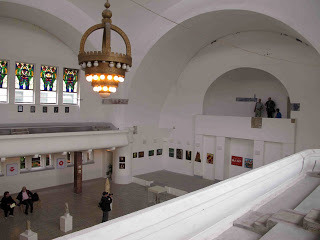
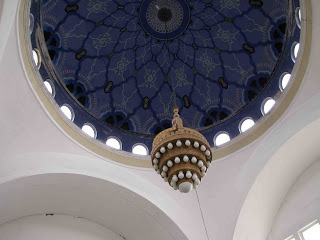
Above photos (c) Ruth Ellen Gruber
Published on August 24, 2011 01:48
August 20, 2011
Slovakia -- Rabbi Andrew Goldstein on Synagogues, Memory and Future
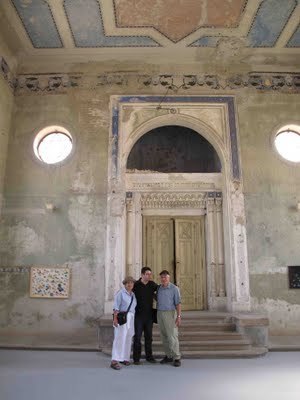
The Goldsteins and Maros Borsky in Samorin synagogue. Photo (c) Ruth Ellen Gruber
By Ruth Ellen Gruber
Rabbi Andrew Goldstein, who was on the recent trip in Slovakia to tour the Slovak Jewish Heritage Route, gave an eloquent sermon this week in his synagogue in London that evoked what we saw -- and raised important questions regarding surviving sites of Jewish heritage and their place, role and future. These issues have been a continuing focus of this blog, and (of course) of anyone involved in the field. In 2009, a conference in Bratislava was devoted to these issues and formulated a series of "best practices" recommendations to consider when dealing with disused or abandoned Jewish sites.
Rabbi Goldstein is the chairman of the European Union for Progressive Judaism and has spent decades traveling and teaching in east-central Europe.
SLOVAK SYNAGOGUE SERMON
What do you do with a synagogue building that becomes redundant? What do you do if the community shrinks and can no longer support a congregation or the upkeep of the building?
I wonder if our friends at Harrow and Wembley Progressive spent long searching the Talmud to see what were their options: as you know they recently sold their building to a fundamentalist Christian church and moved in with Middlesex New...Reform synagogue. A brief look at the rabbinic sources says you can sell a synagogue if you use the proceeds to build another: which lets Harrow & Wembley off the hook, or for community benefit: which was certainly the case when North London sold their building. The Talmud says you may sell a synagogue on condition that its not going to be turned into a wash-house, a tannery, a bath-house or a toilet. What about a church?
It seems as if once a month you read in the Jewish Chronicle of an English synagogue being closed as its congregation dwindles and a number have become evangelical churches and increasingly mosques. Just think of the famous Brick Lane building that started out as a church, then an ultra-Orthodox synagogue and now a mosque. And I suppose we should recall that NPLS started out by using a former Primitive Methodist church as it first synagogue. The continued use of a redundant building for religious purposes seems appropriate, but often British shuls seem to be turned into blocks of flats or office buildings: at least I have not heard of a tannery or public convenience.
Sharon and I have just returned from a fabulous tour round Slovakia as guests of the Slovak Tourist Board, arranged by our friend Maros Borsky. The idea was to take journalists along the Slovak Jewish Heritage route that Maros has developed. Photographs of which we saw displayed in our Art Gallery a few weeks ago: we visited the actual sites, along with journalists from Israel, Hungary & Italy. The Israelis were all secular, yet seemed genuinely moved by Sharon singing Psalms in the empty shuls we were taken to.
Of course Slovakia is quite different from the UK....because the vast majority of its Jewish population was wiped out in the Holocaust. And of those of who survived, most left the country after the war with its take-over by the Communists or during the brief window of opportunity during the Prague Spring. Since the end of communism the community has dwindled further and those that have stayed have tended to move to the capitol Bratislava that nowadays has the only viable Jewish community in the country.
Unlike neighbouring Poland and Austria and Ukraine, unlike Germany, very few Slovak (or Czech) synagogues were actually destroyed during the Holocaust (sadly one of the few was in Spisske Nova Ves where our Slovak Torah comes from). The Communists, however, destroyed many buildings or used them for, often quite unfitting purposes: Bingo halls, markets, store-rooms: though so far I've not discovered a tannery. The Communists also destroyed the surviving Jewish community; and for all of these reasons there are hundreds of Jewish buildings and cemeteries in places, quite often in large towns, where there is not one living Jew residing.
What is the present day Jewish community to do with this vast number of Jewish sites? It cannot preserve and look after everything. Maros Borsky has persuaded the community leaders to concentrate on just a few buildings and cemeteries of special historic or architectural merit. Places that might have a long-term future, that might give evidence of the former glory of the country's Jewish community. Then Maros came up with the idea of a Slovak Jewish Heritage Route that tourists could follow to experience this treasure trove of Jewish beauty.
This was the route Sharon and I along with the 8 professional journalists followed a week ago.
To justify our trip, we too must attempt to get published articles encouraging others to visit Slovakia and, at least, seek out a few of the buildings on the route, and soon I must get down to write a few articles, so this sermon is a first attempt. Tonight, as a theme, I will answer the question I posed at the beginning: what is a fitting use for a redundant synagogue? For a fitting use is one of Maros' criteria as well as a local body able to guarantee a long term future for the building.
The Route starts in Bratislava where Maros is concentrating in converting the woman's gallery in the only remaining synagogue into an exhibition of Judaica from the collection of the community. Downstairs the sanctuary will remain for High Holyday services, the weekly minyan more comfortable in the small "Winter" synagogue. Presov, in the far east of the country, also has a historic Judaica collection in the gallery, though there is rarely a minyan to davven in, perhaps, the most fabulously decorated of all the shuls in the country. It stands in a compound that contains 3 other former synagogues, now used as office buildings. Further east is Bardeov where a tiny shul, a stieble indeed, is preserved exactly as it was when the last Jews were deported 70 years ago. The Orthodox synagogue in Zilina is also intact, though I was saddened to hear that services don't actually take place there: on Rosh Hashanah the tiny community meet in a nearby hall and reminisce - seemingly nobody to lead even a short service. A small exhibition in the women's section is visited by local school groups, but I was interested in a showcase with a selection of Table Tennis memorabilia: once Zilina the centre of the Jewish game. Trnava has two synagogues: one once Orthodox and Neologue and both have been turned into are galleries. The former expensively repaired with the vividly painted walls & ceiling restored to their former glory. The Neologue made safe, but left to remind visitors of its neglected state, a result of the destruction of its community, a reminder of the Shoah. I'm not sure which is the better state for a redundant synagogue found a new use.
The synagogue in Nitra is used as a concert hall and Sharon and I, on a previous visit, heard a children's concert there. Upstairs is Slovakia's official Holocaust memorial exhibition, and on the stairs a collection of prints of Nitra born Shraga Weil. Perhaps a perfect combination for a beautiful building, restored and looked after by the municipality: a reminder of the fate of its past worshippers and yet regularly used for inspiring music. Please God this will be the eventual fate of the magnificent building in Liptovsky Mikulas where we had one of the most moving experiences of our tour. One of our party, David Sivor had there had his Bar mitzvah, and in the now empty sanctuary recalled the event, and Sharon sang Psalms: the acoustics perfect; for a brief moment a reminder the large community that once worshipped in that place.
The future of the Jewish community in Slovakia is uncertain but, at least, through the inspiration of Maros Borsky, they now have a splendid Heritage Route that will long tell of the glory of the former community. Many other stories I could add, especially about our visit to the cemetery in Spisske nova Ves, our Torah town, where Dr Ruzena Kormasova and her High School students continue to research the history of the town's former Jewish community and look after the cemetery. But how appropriate that I tell my story on an evening where we include in our service the blessing of a baby whose mother, if not Slovak - is Czech. Thank God our congregation is thriving: perhaps it has always been like this in Jewish history: Jewish life in one country declines, but the Jewish people and Judaism lives on in places new.
Rabbi Dr Andrew Goldstein19th August 2011....19th Av 5771
Published on August 20, 2011 01:15
August 19, 2011
Painted gravestone decoration
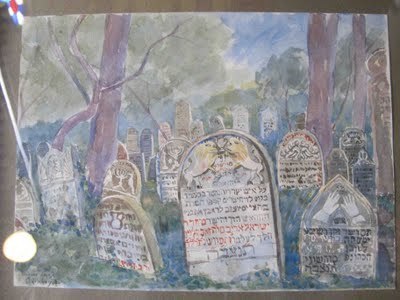
By Ruth Ellen Gruber
During my recent trip visiting Jewish heritage sites in Slovakia, I came across some artwork that demonstrated the way Jewish gravestones were often painted in various colors to emphasize the carved ornamentation. (I have posted on this in the past, and have also posted pictures showing gravestones in Romania, Poland and Ukraine where you can still see traces of such polychrome decoration.)
The watercolor pictured above is a view of the Jewish cemetery in Ungvar (today Uzhorod, Ukraine) painted in 1930, apparently by Eugen Barkany, who assembled the wonderful collection of Judaica and other objects that formed the basis of the Jewish museum founded in Presov, in eastern Slovakia, in 1928. (At the time both Uzhorod and Presov were part of Czechoslovakia -- to see old postcards of Uzhorod, click HERE.) The painting clearly shows the polychrome decoration.
The Barkany collection is now displayed in the women's gallery of the marvelously ornate Orthodox synagogue in Presov, a stop of the Slovak Jewish Heritage route (scroll down for previous posts on this route).
Here are some other paintings of cemeteries and stones by Barkany, from 1930, on display:
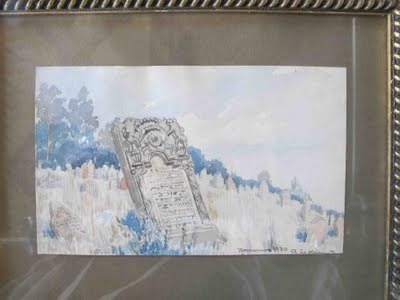
Can't read it well -- but, Humenne? (near Presov)
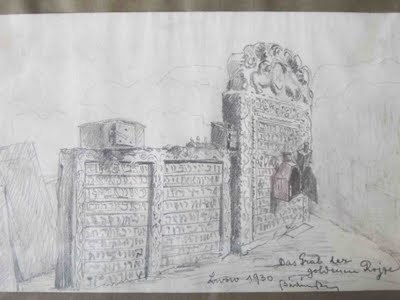
Lwow/L'viv -- tomb of the "Golden Rose" (cemetery has been destroyed)
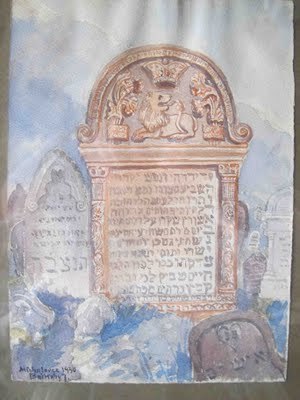
Michalovce
Published on August 19, 2011 06:02
August 17, 2011
Slovakia -- Yet More from the Jewish Heritage Route: Malacky
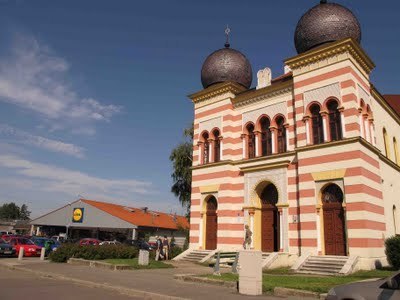
Malacky - synagogue and discount supermarket. Photo (c) Ruth Ellen Gruber
By Ruth Ellen Gruber
I've always been very fond of the spritely little synagogue in the town of Malacky, just off the highway north of Bratislava. It's a charming Moorish-style building, built for the town's Neolog (reform/conservative) Jewish community in 1886-87 and designed by Bratislava-born Wilhelm Stiassny, one the leading synagogue architects of the day in central Europe. (Stiassny also designed the Jeruzalemska st. synagogue in Prague and the synagogue in Caslav, CZ).
I visited Malacky during my five days this month following the Slovak Route of Jewish Heritage -- a project devised by my friend Maros Borsky, the leading expert on Jewish heritage in Slovakia. The author of the book Synagogue Architecture in Slovakia, Maros founded and directs the Slovak Jewish Heritage Center. You can see earlier posts on the trip HERE and HERE and HERE and HERE .
With its cream and orange striped exterior, two bulbous side domes topped with stars of David, horseshoe arches and bright blue and yellow decorative detail, the building looks wonderfully cheery but totally out of place: an exotic holdover from some prior life amid a concrete urban setting of parking lots, a supermarket (the ubiquitous discount "Lidl"), apartment blocks and other modern development.
It is a unique reminder of the destroyed community and its world: indeed, it's really the loveliest building in the town.
I was pleased to see that the local muncipality recognizes this -- we were given souvenir coffee mugs and refrigerator magnets with the synagogue's picture on it. OK, it commercializes the -- burtally destroyed -- past, but it also recognizes it....
The synagogue is now used as an art school, and the sanctuary was cut in half horizontally, to create two floors.
Still, much of the lush interior décor has been preserved in fine condition and almost intact -- though downstairs the Ark, pillars and other decoration are somewhat obscured by the school's clutter.
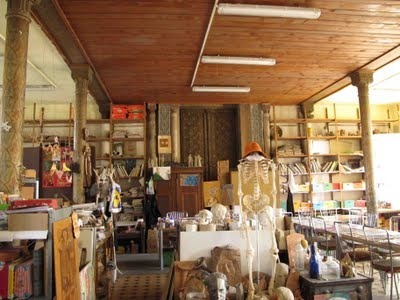
Malacky -- downstairs in the art school. Photo (c) Ruth Ellen Gruber
The upper floor, used as a concert hall, features a wonderful, ornately carved and painted wooden ceiling, as well as the top part of the ark, with its decorative motif of grape vines.
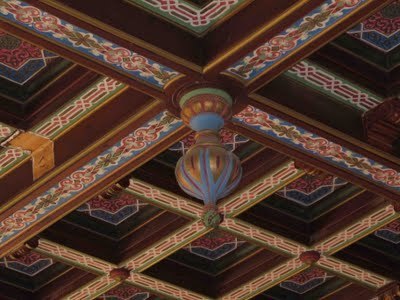
Malacky -- upstairs detail of ceiling. Photo (c) Ruth Ellen Gruber
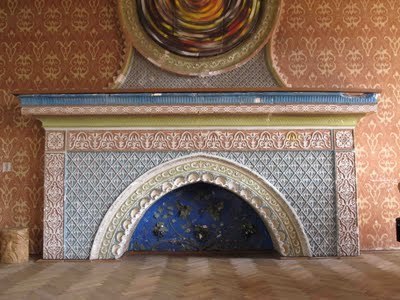
Malacky -- the upper part of the Ark. Photo (c) Ruth Ellen Gruber
Published on August 17, 2011 08:19
August 14, 2011
Slovakia -- Liptovsky Mikulas Synagogue (including video)
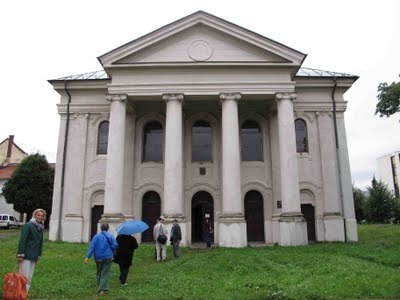
Liptovsky Mikulas synagogue. Photo (c) Ruth Ellen Gruber
By Ruth Ellen Gruber
The magnificent neoclassical (former) synagogue in Liptovsky Mikulas, at the edge of the Tatra Mountains, was one of the highlights during my five days this month following the Slovak Route of Jewish Heritage -- a project devised by my friend Maros Borsky, the leading expert on Jewish heritage in Slovakia. The author of the book Synagogue Architecture in Slovakia, Maros founded and directs the Slovak Jewish Heritage Center. You can see earlier posts on the trip HERE and HERE and HERE .
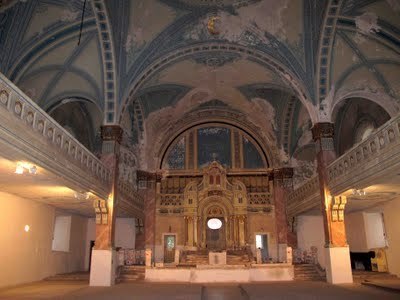
Interior. Photo (c) Ruth Ellen Gruber
Built in 1846, the synagogue is now surrounded by parking lots, modern construction and a very, very few lingering old houses. The synagogue was partially restored in the 1990s for use as an exhibition hall. Only traces remain of the sumptuous interior decoration, including an elaborate Ark, designed by my architectura hero -- the prolific Hungarian synagogue architect Lipot Baumhorn, who renovated the building in 1904-1906 after it was gutted by fire. My long chapter on Baumhorn in my 1994 book Upon the Doorposts of Thy House was, I believe, the first lengthy treatment of him and his work in English -- and it still may be so, though I understand a student in Budapest is now doing her PhD on Baumhorn.
While I was researching that book, I brought my mother, the artist Shirley Moskowitz, with me on one trip. She did a series of monotype prints of Jewish heritage sites we saw -- including the Ark of the synagogue in Liptovsky Mikulas.
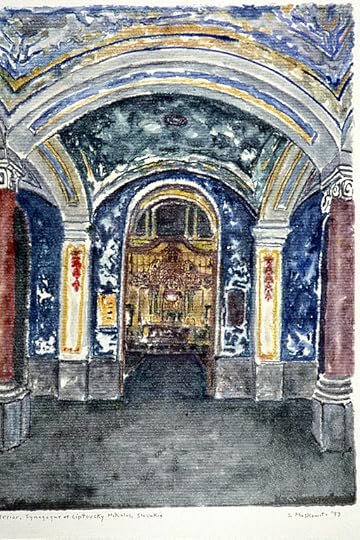
(c) The Estate of Shirley Moskowitz
While in the synagogue, Rabbi Andrew Goldstein and his wife, Sharon, recited and sang prayers associated with synagogues in an informal commemorative service for the building and its community. It was a beautiful and moving experience.
Liptovsky Mikulas was the first city in then-Hungary to elect a Jewish mayor; Isaac Diner, elected in 1865, was the first of several Jews to serve in the post.
Published on August 14, 2011 02:28
August 13, 2011
Slovakia -- More highlights from Slovak Jewish Heritage Route -- Presov

Mezuzahs in Barkany Judaica collection. Photo: (c) Ruth Ellen Gruber
By Ruth Ellen Gruber
Here are further highlights from my five days following the Slovak Route of Jewish Heritage -- a project devised by my friend Maros Borsky, the leading expert on Jewish heritage in Slovakia. The author of the book Synagogue Architecture in Slovakia, Maros founded and directs the Slovak Jewish Heritage Center. You can see earlier posts on the trip HERE and HERE.
A major stop on the journey was the Presov, in the far east of Slovakia, the country's third largest city.
Here we visited the orthodox Jewish compound, centered on the large and sumptuous orthodox synagogue, built in 1898. It is a wonderfully ornate building -- still used by the tiny Jewish community -- that testifies to the one-time size and prosperity of the community here. The women's gallery houses the wonderful Barkany collected of Judaica that was collected for what was the first Jewish museum in the region, which opened in Presov in the 1920s. Alas, it is a branch of the State-run Museum of Jewish Culture in Bratislava and suffers the same lack of information on the objects. But what is there is really wonderful.
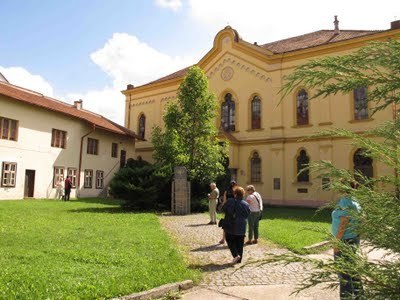
Exterior of Presov orthodox synagogue. Photo (c) Ruth Ellen Gruber
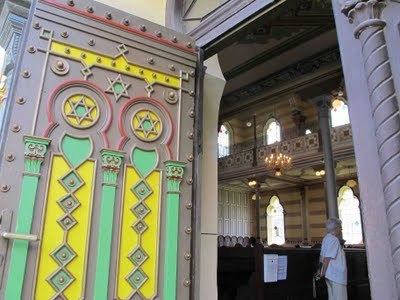
Door into sanctuary. Photo (c) Ruth Ellen Gruber
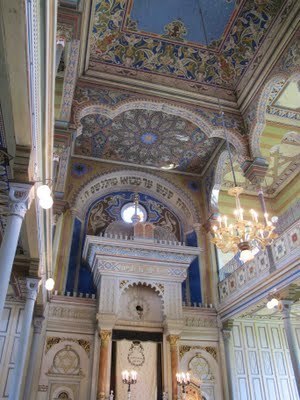
Presov: Ark and Ceiling. Photo (c) Ruth Ellen Gruber
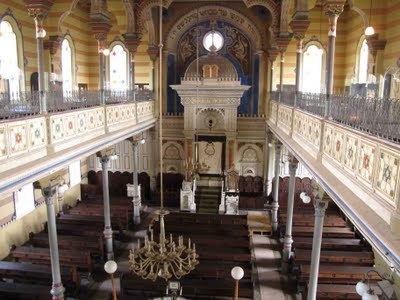
Sanctuary. Photo (c) Ruth Ellen Gruber
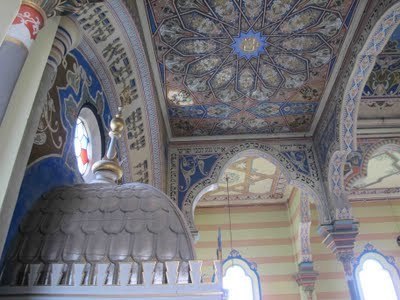
Ceiling near Ark. Photo (c) Ruth Ellen Gruber
Published on August 13, 2011 08:44
August 12, 2011
Slovakia - More on the Jewish Heritage Route
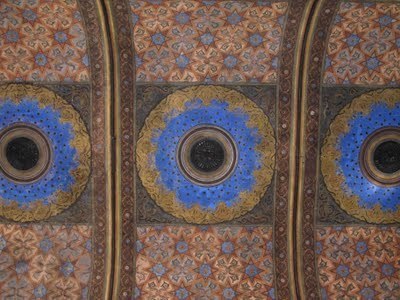
Ceiling, Orthodox synagogue, Trnava. Photo (c) Ruth Ellen Gruber
By Ruth Ellen Gruber
I spent the past five days following the Slovak Jewish Heritage Route -- 14 or 15 sites (out of the 24 on the Route) in all parts of Slovakia, from Bratislava to Presov and back. We stayed in top hotels but for some reason I never had a good enough internet connection to post on this blog. So here are a few highlights, with more detailed posts to come.
Synagogues -- we saw all types. Some fully restored and used for various purposes, some in use as synagogues, some under restoration.
The oldest was that in Stupava, not far from Bratislava. It was built in 1803 and is one of the oldest int he country -- one of only two built in the "Polish" nine-bay style with a four-pillar bimah supporting the vauted ceiling. The one in Stupava belongs to a private citizen, Tomas Stern, a doctor and businessman who bought it for almost literally nothing and has been restoring it as a sort of hobby (for years he documented Jewish heritage sites in Slovakia).... He will be getting married there (officiated by the Bratislava rabbi) at the end of August!
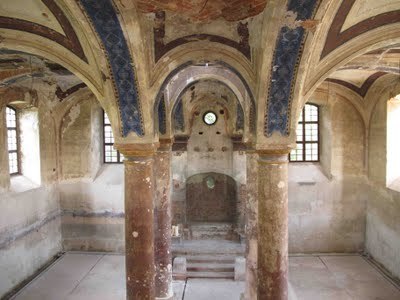
Stupava interior. Photo (c) Ruth Ellen Gruber
One of the most exciting moments for me was to see the newly restored Orthodox (or Small) synagogue in Trnava, north of Bratislava. The Status Quo synagogue was restored in the mid-1990s as a contemporary art gallery -- a restoration that was daring, in that it preserved vivid signs of the damage and devastation that the synagogue underwent during and after WW2. From the outside, it even still looks like a ruin.
But the Orthodox synagogue across the street remained locked and abandoned; disused and in terribly neglected shape. It has recently though been acquired by a private investor, beautifully restored (also preserving signs of damage) and opened as the private Max Gallery. There is talk now of a collaboration between the two synagogue galleries -- I hope so.
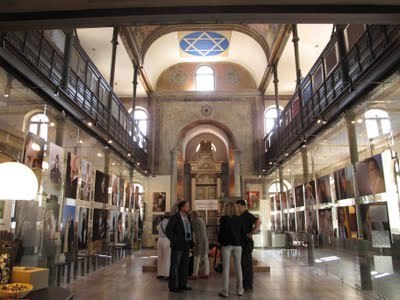
Trnava Orthodox Synagogue. Photo (c) Ruth Ellen Gruber
Published on August 12, 2011 09:45



